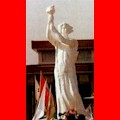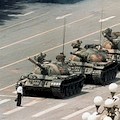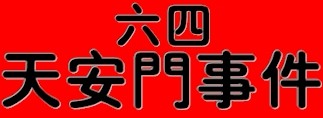





 |

 |
 |
 |
||

|
|
|||
 |
||||
There is a dedicated forum for discussion on this topic.
Recent Posts to the Forum
This project was started on:
June 04, 2009 05:10:42This project was last updated on:
March 22, 2011 01:01:46
- Introduction
- It Began In Mourning
- An 80 Year Anniversary
- Cries For Democracy Begin
- Internal Dissent
- The Media and International Response
- The Massacre Begins
- 'Tank Man'
- Impact
- Taboo
- Anniversaries
- It Ends In Mourning
- Sources
SEE Also:
The Tiananmen Square protests of 1989 culminating in the Tiananmen Square massacre (referred to in China as the June Fourth Incident, ostensibly to avoid confusion with two prior Tiananmen Square protests) were a series of demonstrations in and near Tiananmen Square in Beijing in the People's Republic of China (PRC) beginning on 14 April. Led mainly by students and intellectuals, the protests occurred in a year that saw the collapse of a number of communist governments around the world.
The Tiananmen Square protests in 1989 were in large measure sparked by the death of former Secretary General Hu Yaobang: Hu Yaobang's resignation from the position of Secretary General of the CPC had been announced on 16 January 1987. His forthright calls for "rapid reform" and his almost open contempt of "Maoist excesses" had made him a suitable scapegoat in the eyes of Deng Xiaoping and others, after the pro-democracy student protests of 1986–1987. Included in his resignation was also a "humiliating self-criticism", which he was forced to issue by the Central Committee of the Communist Party. Hu Yaobang's sudden death, due to heart attack, on 15 April 1989 provided a perfect opportunity for the students to not only mourn the deceased Secretary General, but also to have their voices heard in "demanding a reversal of the verdict against him" and bringing renewed attention to the important issues of the 1986–1987 pro-democracy protests and possibly also to those of the Democracy Wall protests in 1978–1979. Small voluntary civilian gatherings started on 15 April around Monument to the People's Heroes in the middle of the Tiananmen Square in the form of mourning for Hu Yaobang. Many students in Peking University and Tsinghua University expressed their sorrow and mourning for Hu Yaobang by posting eulogies inside the campus and erecting shrines, some students joined the civilian mourning in Tiananmen Square in a piecemeal fashion. Organized student gatherings started outside of Beijing on a small scale in Xi'an and Shanghai on 16 April.
On the afternoon of 17 April, in Beijing, 500 students from China University of Political Science and Law marched to the eastern gate of the Great Hall of the People, part of Tiananmen Square, and commenced the mourning activities for Hu Yaobang. The gathering in front of the Great Hall of the People was soon deemed obstructive to the normal operation of the building, police intervened and attempted to disperse the students by persuasion. The gathering featured speakers from various backgrounds giving public speeches (mostly anonymous) commemorating Hu Yaobang, expressing their concerns of social problems. Starting midnight on 17 April, three thousand students from Peking University marched from the campus towards Tiananmen Square, and soon nearly a thousand students from Tsinghua University joined the ranks. Upon arrival, they soon joined forces with students and civilians who were in the Square earlier. As its size grew, the gathering of mourning was gradually evolving into a "petition" nature, as students were now drafting a list of pleas and suggestions (list of seven demands) they would like the government to listen to and carry through.
In the morning of 18 April, students remained in the square. Some gathered around the Monument to the People's Heroes singing patriotic songs and listening to impromptu speeches by the student organizers. There were another portion of students sitting-in in front of the Great Hall of the People, the office of the Standing Committee of the National People's Congress; they demanded to see members of the Standing Committee and offered the list of seven demands. Meanwhile, a few thousand students gathered in front of the Zhongnanhai building complex, the residence of the government, demanding to see government leaders and answers to their earlier demands. Students tried to muscle their way through the gate by pushing, but security and police locking arms formed a cordon that eventually deterred students' attempts to enter through the gate. Students then staged a sit-in. Some government officials did unofficially meet with student representatives. Unable to see an official response, there was a growing frustration amongst students.
On 20 April, police finally dispersed the students in front of the Zhongnanhai with force, to ensure proper function of the building complex. The police employed batons and minor clashes were reported. The protests in Tiananmen Square gained momentum after news of the confrontation between students and police spread; the belief by students that the Chinese media was distorting the nature of their activities also led to increased support.
Thousands Descend On The Square
On the night of 21 April, the day before Hu's funeral, some 100,000 students marched on Tiananmen Square, gathering there before the square could be closed off for the funeral.
From 21 April to 23 April, students from Beijing called for a strike at universities, which included teachers and students boycotting classes. The government, which was well aware of the political storm caused by the now-legitimized 1976 Tiananmen Incident, was alarmed. On 26 April, following an internal speech made by Deng Xiaoping, the CPC's official newspaper People's Daily issued a front-page editorial titled Uphold the flag to clearly oppose any turmoil, attempting to rally the public behind the government, and accused "extremely small segments of opportunists" of plotting civil unrest. The statement enraged the students, and on 27 April about 50,000 students assembled on the streets of Beijing, disregarding the warning of a crackdown made by authorities, and demanded that the government retract the statement.
A majority of students from the Beijing's numerous colleges and universities participated with support of their instructors and other intellectuals. The students rejected official Communist Party-controlled student associations and set up their own autonomous associations and viewed themselves as Chinese patriots, as the heirs of the May Fourth Movement for "science and democracy" of 1919. The protests also evoked memories of the Tiananmen Square protests of 1976 which had eventually led to the ousting of the Gang of Four.
From its origins as a memorial to Hu Yaobang, who was seen by the students as an advocate of democracy, the students' activity gradually developed over the course of their demonstration from protests against corruption into demands for freedom of the press and an end to, or the reform of, the rule of the PRC by the Communist Party of China and Deng Xiaoping, the de facto paramount Chinese leader. Partially successful attempts were made to reach out and network with students in other cities and with workers.
While the protests lacked a unified cause or leadership, participants were generally against authoritarianism and voiced calls for democratic reform within the structure of the government. Unlike the Tiananmen protests of 1987, which consisted mainly of students and intellectuals, the protests in 1989 commanded widespread support from the urban workers who were alarmed by the new economic reforms, growing inflation, and corruption. In Beijing, they were supported by a large number of people. Similar numbers were found in major cities throughout mainland China such as Urumqi, Shanghai, and Chongqing; and later in Hong Kong, Taiwan and Chinese communities in North America and Europe.
4 May 1989 marked the 80-year anniversary since the 'May 4th Movement', a student-led protest which marked the beginning of the end of the 'warlord' period in post-imperial China. While those protests were in response to the Chinese government's inaction at the Versailles, Paris peace conference which ended World War I, many student leaders during the 1989 protests evoked images from 1919 to draw comparisons of government inaction and further highlight the influence of students on governmental change.
By 4 May, approximately 100,000 students and workers had marched in Beijing making demands for free media and a formal dialogue between the authorities and student-elected representatives. A declaration demanded the government to accelerate political reform.
The government rejected the proposed dialogue, only agreeing to talk to members of appointed student organizations. On 13 May, two days prior to the highly-publicized state visit by the reform-minded Soviet leader Mikhail Gorbachev, huge groups of students occupied Tiananmen Square and started a hunger strike, insisting the government withdraw the accusation made in the People's Daily editorial and begin talks with the designated student representatives. Hundreds of students went on hunger strikes and were supported by hundreds of thousands of protesting students and part of the population of Beijing, for one week.
Protests and strikes began at colleges in other cities, with many students traveling to Beijing to join the demonstration. Generally, the demonstration at Tiananmen Square was well-ordered, with daily marches of students from various Beijing area colleges displaying their solidarity with the boycott of college classes and with the developing demands of the protest. The students sang The Internationale, the world socialist anthem, on their way to and within the square. The students even showed a surprising gesture of respect to the government by helping police arrest three men from Hunan Province, including Yu Dongyue, Yu Zhijian, and Lu Decheng who had thrown ink on the large portrait of Mao that hangs from Tiananmen, just north of the square.
The students ultimately decided that in order to sustain their movement and impede any loss of momentum, a hunger strike would need to be enacted. The students' decision to undertake the hunger strike was a defining moment in their movement. The hunger strike began in May 1989 and grew to include "more than one thousand persons". The hunger strike brought widespread support for the students and "the ordinary people of Beijing rallied to protect the hunger strikers...because the act of refusing sustenance and courting government reprisals convinced onlookers that the students were not just seeking personal gains but [were] sacrificing themselves for the Chinese people as a whole".
The hunger strike not only gained significant support nationally for the students, but also rang further alarms in China's top leadership. The national press, then still relatively free to cover ongoing events without propagating the party line, aired the talks between Premier Li Peng and student leaders on the evening of 18 May. During the talks Wu'er Kaixi, Wang Dan, and others openly accused the government for being too slow to react and rebuked Li Peng personally for lacking the "sincerity to conduct real discussions". The discussion did not yield much results, but gained student leaders prominent airtime on China's national television. Li Peng and other leaders, however, maintained the government was only trying to "maintain order", but alluded to the students actions as "patriotic".
As the hunger strike escalated, numerous political and civil organizations around the country voiced their concern for the students, many empathizing with their positions. The Chinese Red Cross issued a special notice and sent in a large number of personnel to provide medical services to the hunger strikers on the Square. For the first time, on 19 May, two of the highest ranked members of China's central leadership, Premier Li Peng and General Secretary Zhao Ziyang went to Tiananmen personally in an attempt neutralize the situation.
At 4:50 am, Zhao Ziyang went to the Square and made a speech urging the students to end the hunger strike. Part of his speech was to become a famous quote, when he said, referring to the older generation of people in China, "We are already old, it doesn't matter to us any more." In contrast, the students were young and he urged them to stay healthy and not to sacrifice themselves so easily. Zhao's emotional speech was applauded by some students on the Square; it would be his last public appearance.
Partially successful attempts were made to negotiate with the PRC government, who were located nearby in Zhongnanhai, the Communist Party headquarters and leadership compound. Because of the visit of Mikhail Gorbachev, foreign media were present in China in large numbers. Their coverage of the protests was extensive and generally favorable towards the protesters, but pessimistic that they would attain their goals. Toward the end of the demonstration, on 30 May, a statue of the Goddess of Democracy was erected in the Square and came to symbolize the protest to television viewers worldwide.
The Standing Committee of the Politburo, along with the party elders (retired but still-influential former officials of the government and Party), were at first hopeful that the demonstrations would be short-lived or that cosmetic reforms and investigations would satisfy the protesters. They wished to avoid violence if possible, and relied at first on their far-reaching Party apparatus in attempts to persuade the students to abandon the protest and return to their studies. One barrier to effective action was that the leadership itself supported many of the demands of the students, especially the concern with corruption. However, one large problem was that the protests contained many people with varying agendas, and hence it was unclear with whom the government could negotiate, and what the exact demands of the protesters were. The confusion and indecision among the protesters was also mirrored by confusion and indecision within the government. The official media mirrored this indecision as headlines in the People's Daily alternated between sympathy with the demonstrators and denouncing them.
Among the top leadership, General Secretary Zhao Ziyang was strongly in favor of a soft approach to the demonstrations, while Li Peng was seen to argue in favor of a crackdown. Ultimately the decision to forcefully intervene on the demonstrations was made by a group of Party elders, who saw abandonment of single-party rule as a return of the chaos of the Cultural Revolution. Although most of these people had no official position, they were able to control the military. Deng Xiaoping was chairman of the Central Military Commission and was able to declare martial law; Yang Shangkun was President of the People's Republic of China, which, although a symbolic position under the 1982 Constitution, was legally the commander-in-chief of the armed forces. The Party elders believed that lengthy demonstrations were a threat to the stability of the country. The demonstrators were seen as tools of advocates of "bourgeois liberalism" who were pulling the strings behind the scenes, as well as tools of elements within the party who wished to further their personal ambitions.
The Media and International Response
At the beginning of the movement, the Chinese news media had a rare opportunity to broadcast the news freely and truly. Most of the news media were free to write and report however they wanted, due to lack of control from the central and local governments. The news was spread quickly across the land. According to Chinese news media's report, students and workers in over 400 cities, including cities in Inner Mongolia, also organized and started to protest. People also traveled to the capital to join the protest in the Square.
University students in Shanghai also took to the streets to commemorate the death of Hu Yaobang and protest against certain policies of the government. In many cases, these were supported by the universities' Party committees. Jiang Zemin, then-Municipal Party Secretary, addressed the student protesters in a bandage and 'expressed his understanding', as he was a former student agitator before 1949. But at the same time, he moved swiftly to send in police forces to control the streets and to purge Communist Party leaders who had supported the students.
On 19 April, the editors of the World Economic Herald, a magazine close to reformists, decided to publish, in their 24 April #439 issue, a commemorative section on Hu. Inside was an article by Yan Jiaqi, which commented favorably on the Beijing student protests on 18 April and called for a reassessment of Hu's purge in 1987. On 21 April, a party official of Shanghai asked the editor in chief, Qin Benli, to change some passages. Qin Benli refused, so the official turned to Jiang Zemin, who demanded that the article be censored. By that time, a first batch of copies of the paper had already been delivered. The remaining copies were published with a blank page. On 26 April, the "People's Daily" published its editorial condemning the student protest. Jiang followed this cue and suspended Qin Benli. Jiang's quick rise to power following the 1989 protests has been attributed to his decisive handling of these two events.
The international media had been in Beijing to cover the scheduled 14 May visit of Soviet Premier, Mikhail Gorbachev.
Across the world, especially where Chinese lived, people gathered and protested. Many governments, such as those of the USA, Japan, etc., also issued warnings advising their own citizens not to go to the PRC.
In Hong Kong, on 27 May 1989, over 300,000 people gathered at Happy Valley Racecourse for a gathering called "Democratic songs dedicated for China." Many Hong Kong and Taiwanese celebrities sang songs and expressed their support for the students in Beijing. The following day, a procession of 1.5 million people, one fourth of Hong Kong's population, led by Martin Lee, Szeto Wah and other organization leaders, paraded through Hong Kong Island.